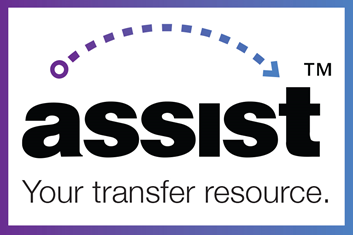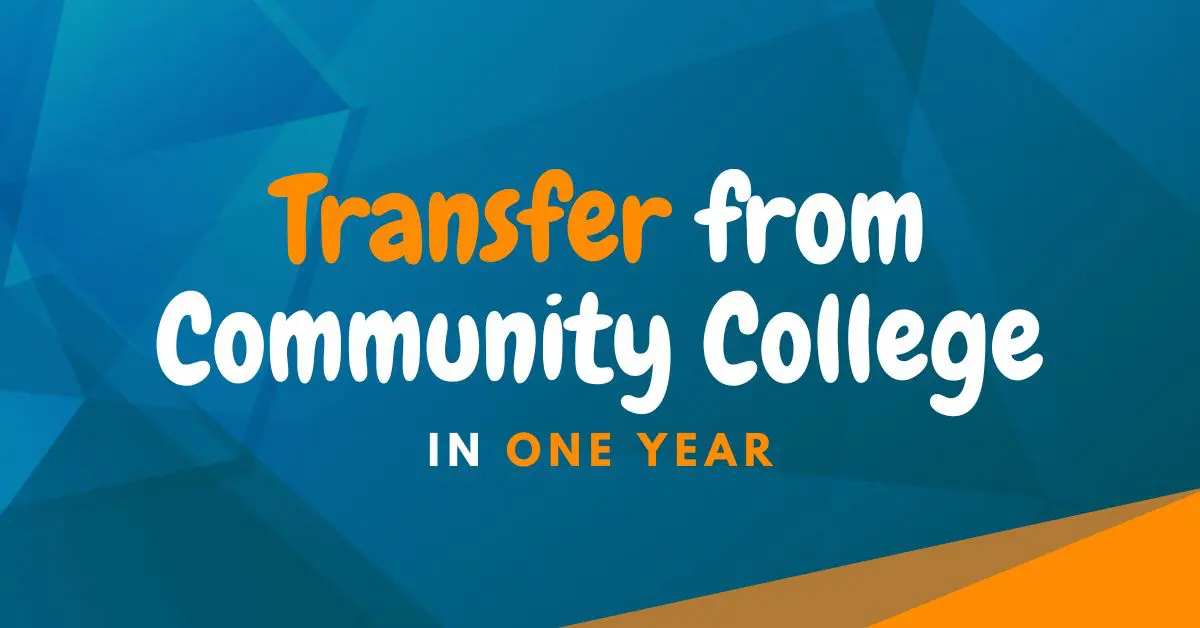So you want to transfer from a community college in one year? Is it possible? Of course, it is possible, but it requires immense work and motivation. In this article, I’ll outline measures to transfer from community college to university.
Inform Your Community Colleges Counselor of your Intention and Meet with Them
First and foremost, you need to have your ducks in a row. This means clearly understanding what classes you need to take to fulfill university requirements. You can do this by meeting with your counselors.
At this meeting, you can gain valuable information about the transfer process, articulation agreements, associate degree programs, and how many transfer credits you have as an incoming community college transfer student.

Moreover, different community colleges have additional requirements for scheduling a meeting. Still, most have a team of academic and transfer advisors to help make you comfortable at your new school.
It is also a valuable time to select some classes to take over the Summer as it will be necessary if you are interested in transferring in one year comfortably (more likely than not). Gauging how many transferable credits your future university accepts will put your mind at ease for the transfer admissions process.
Identify Transferring Credits
The rise in Advanced Placement and Dual Enrollment courses has resulted in several high school students achieving a high school diploma with credit hours for college.
Advanced Placement (AP)
AP courses are essential in your success of transferring in one year. If you do not have AP credit, the likelihood of transferring in one year is practically zero. Allow me to explain.
A 3, 4, or 5 on any given AP test can be used for college credit at the community college and four-year school you are interested in. Depending on your score, you may be exempt from taking certain classes or prerequisites necessary for your major. As such, skipping the prerequisites allows you to enroll immediately in the course that will contribute to transferring.
I will say that the articulation with AP credits is probably the most complex part of the process. Although schools try to make it easy with AP Credit Evaluations and AP Exemption lists, students are often confused by the AP credit they receive and whether it exempts them from a particular set of courses.
The best way to evaluate your AP tests is to send a request to CollegeBoard early and have your AP Score Report sent to the registrar’s office at your community college. When the registrar’s office receives your AP Score Report, they will conduct an evaluation and inform you of the core curriculum or major prerequisite courses you are exempted from taking.
Dual Enrollment
Various California high schools offer the ability for students to take dual enrollment courses. These are college courses that high schoolers take on campus that will count for college credit upon high school graduation.
These classes are typically general education classes and contribute to the prospects of California HS students graduating with college credit already achieved. This will ultimately reduce the time it will take to complete whatever degree program you are interested in, saving money in the long run.
Choose the Basic Courses
When looking to transfer from a community college, paying attention to the core curriculum and courses you need is essential.
Introductory courses, like your English 101 and Psychology 101, are considered general education classes and are transferable to any of the CSUs and UCs you are interested in transferring to.
Therefore, finishing your core classes earlier is beneficial to set yourself up for a smooth transfer in one year because it eliminates any possibility that you did not meet the basic threshold for transfer admission: your general education credits.
Several community colleges provide online classes that students can take advantage of. You can handle all of your general education classes online and in the comfort of your own home.
All your credits will go towards your bachelor’s degree, so you must take all the required courses for a successful transfer. By paying attention to the core curriculum, you can set yourself up for a successful transfer in one year to any of the four-year universities you are interested in.
Become an Expert in Transfer Agreements
If you are interested in knowing what is needed to transfer from community college, becoming an expert in transfer agreements is vital to your community college transfer path. You can save as much money as anyone if you understand the classes your four-year college awards credit for and the different community colleges with those course offerings.
What is an articulation agreement?
Many two-year community colleges and 4-year universities have formal agreements regarding student transfer. This agreement is known as an articulation agreement. The best way to prepare to transfer is to understand the type of agreement you are targeting between your community college or the university you’ve chosen.
This doesn’t seem complicated. It is simply a telephone conversation or email to a college advisor and asks if the two have a mutual understanding of articulation. If you ask for more information about this service, the academic adviser at your target university will help you.
Read More About Articulation Agreements: COMMUNITY COLLEGE TRANSFER STUDENTS: ARTICULATION AGREEMENT
Why are articulation agreements important for transfer students?
Articulation agreements are essential because they are the only document that shows the exact courses you need to transfer in plain black and white.

Transfer agreements are granted partnership agreements between your community college and four-year college over the transferability of your college credits and whether they can be used to help in your path to acquiring a bachelor’s degree.
Finding Articulation Agreements Using ASSIST
If you are a California community college student, finding the articulation agreements between your target school and community college is as easy as navigating Assist.org.
This resource is the official California community college and university articulation information repository. Be sure to check with the four-year university transfer advisor to seek the newest articulation agreements, as some articulation agreements vary depending on the four-year school or future university you are attending.
What is ASSIST?
ASSIST is an online student-transfer information system that shows how course credits earned at one public California college or university can be applied when transferred to another.
ASSIST aims to promote student success by providing accurate and reliable information about opportunities for transferring course credits among the state’s public colleges and universities.

ASSIST is the result of a collaborative effort among the California Community Colleges (CCC), the California State University (CSU) campuses, and the University of California (UC) campuses.
Using ASSIST, you can determine which courses from your community college can be applied when transferred to a CSU or UC campus.
Read More About ASSIST: THE ULTIMATE GUIDE TO TRANSFERRING WITH ASSIST
Ensure Good Grades
Everything I said earlier is useless if you are not succeeding in your classes. Achieving high-grade marks would be at the top of this list if it were organized by priority or importance. Under no circumstances can students transfer in one year if they have to take remedial classes due to poor performance in the beginning.
Community college is an excellent way to gain valuable study skills and learn how to navigate college life. Although different, the two-year college environment provides immense benefits compared to four-year institutions, particularly for those who are unwavering in their commitment to transferring in one year.
Make sure you attend lectures and contribute to the classroom discussion. This will showcase that you are engaged in the coursework and demonstrates to other college students that you are on a path to success.

If you successfully achieve good grade marks for all your classes, consider the prospects of an associate’s degree, a two-year degree that your attending community college provides if you complete 60 units or more of college coursework.
An associate’s degree is also a valuable mechanism to transfer in higher education systems like California, where the Associate’s Degree for Transfer (ADT) Program guarantees admission to any participating UCs or CSUs if the student completes any associate’s degree programs.
Remember, one year is not enough time to come back from a poor grade in a class. You are at the mercy of your choices when deciding to transfer in one year, and to say it will be difficult is an understatement, especially for interested STEM majors.
Be Cautious of Deadlines
Deadlines can be overwhelming for most students, especially those trying to transfer earlier to university. As noted earlier, the academic advisors at your community college will serve as an invaluable resource in determining when you should transfer community college credits to a university.
Related: When do UC Decisions Come Out? 2023 UC Decision Date
Remember that if you are applying for financial aid, you must fill out the necessary filings to achieve consideration upon enrolling in your bachelor’s degree program. Be cautious of your community college’s policy on financial aid instruments and whether they have the option of finding scholarships for you who may be eligible.

Moreover, if you intend to transfer within one year, you will have to start your college applications earlier than most students. You should prioritize knowing the deadlines for your transfer target school because you will apply the Fall application cycle after enrolling in your community college.
Speak with the Intended Transfer Institution Office
Many community colleges offer developmental education advice. All the experts will assist you closely. They will advise you on the right course to enroll in and make your plan for transferring once you finish school.
Make an early appointment to see your counselor before your move is complete. Some universities have designated admission officers who can help transfer students apply. Get in touch with the individual for a good transfer plan and see if the target institution has a guaranteed admission pathway for students with an associate’s degree.
Transferring to Private Colleges vs. Public Four-Year Colleges
Transferring to a private institution is different from public four-year colleges. The information presented thus far illustrates the traditional transfer arrangements between public two-year colleges and public four-year schools.
Thus, if you are considering a transfer to a private university, like the University of Southern California (USC), then you should see how transferring credits work at that institution. The best way to do this is to speak with your academic advisor at your current school and the admissions counselor at the private institution you want to attend.
The different requirements to transfer to a private university from a two-year school could be minimal. Still, they also could be significant depending on the selectivity of your chosen major.
For example, suppose you attend Santa Monica College and want to transfer to the USC School of Cinematics Arts as a film major. In that case, you will need more specific transfer credits than other students because USC is widely known for the professionalism and quality of its Cinematic Arts program.

Private educational institutions may have an articulation agreement with your school. They can show you which community college courses will transfer and how many credits are needed for a college degree.
Closing Thoughts
Transferring from a community college to a university in one year is possible, but it will require a lot of hard work. You should prepare by speaking with your counselor and informing them of your intention to transfer in one year. Next, select your major and the target institution you want to transfer to and stick with this decision, as changing will undoubtedly restrict your ability to transfer in one year.
Some students want to enroll in a community college to save money and will take an online course at their local community college rather than an expensive university. General education courses are the same regardless of the institution that provides them, so taking GE courses at your local junior college is simply an intelligent decision.
Do not forgo the opportunity to acquire an associate’s degree if it presents itself. Some students can receive an associate’s degree but fail to realize this after leaving college and ultimately forgoing valuable college credit.
Conclusion
Overall, transferring from community college to university is a process that requires focus and engagement. Transferring after one year is incredibly difficult and requires you to work with your new school and four-year college to identify your transfer credits.
Speaking with your counselor and using resources like ASSIST will demonstrate all the credits that can be applied for completing your bachelor’s degree at a four-year university.
Ultimately, it is possible to transfer after one year. Still, all of your energy and focus need to go towards communicating with the professionals at your local institutions and speaking with them about the necessary steps you have to take.
Interested in knowing more about how to transfer after one year? Consider reaching out to our team. We will develop a personalized course schedule to show you what is needed to transfer from community college to any four-year college you are interested in.
California Transfer Support Network is a 501(c)(3) nonprofit organization that supports California Community College students interested in transferring. We provide resume edits, credit evaluations, and workshops for parents and students to learn more about the transfer process.
We run off the generosity of our donors, so if you have the means to do so, consider making a Donation to our organization. All donations are tax-deductible.





